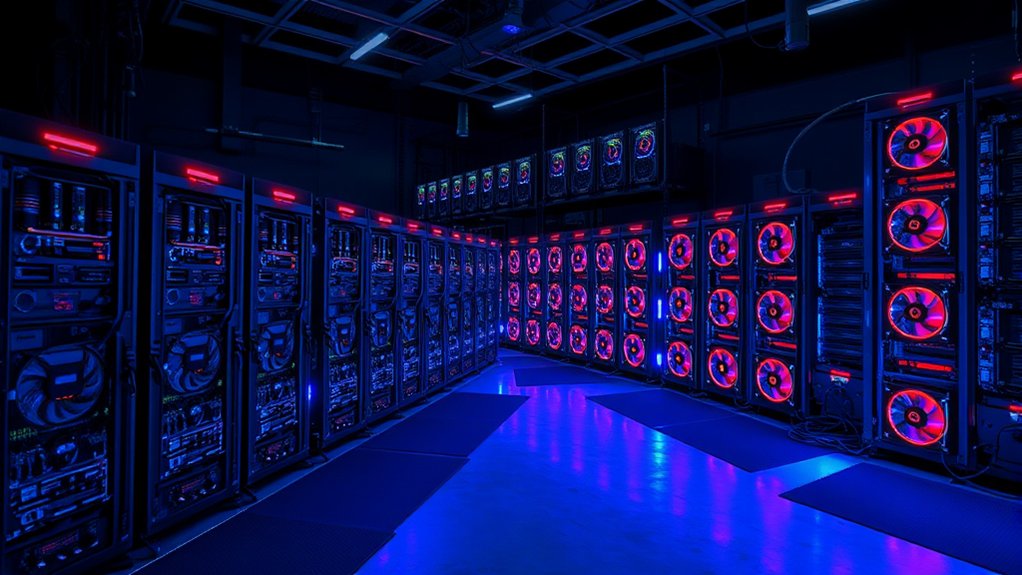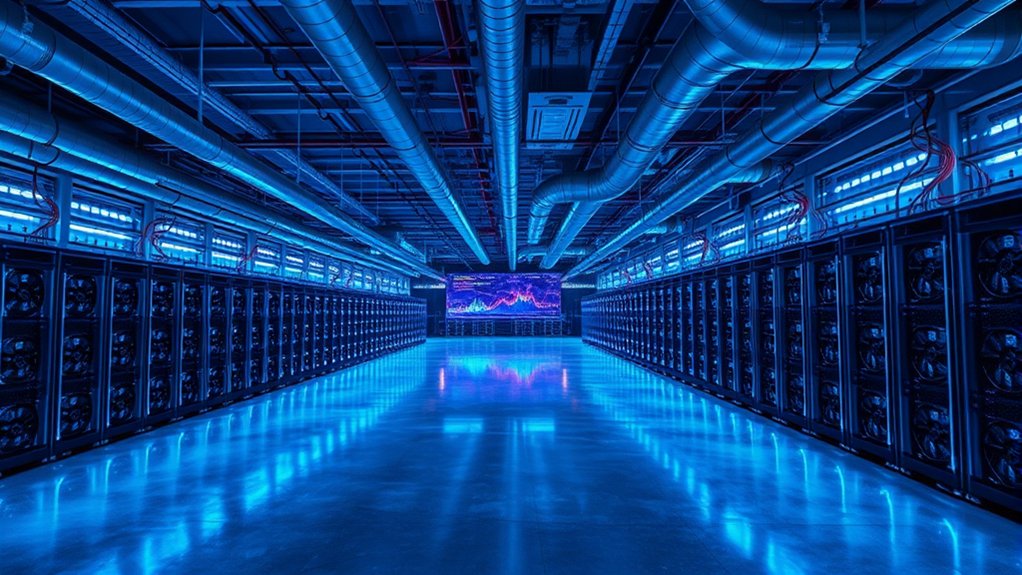A cryptocurrency farm is a big, buzzing operation where supercomputers mine digital currencies by solving complicated math puzzles. It’s all about that sweet blockchain security. Miners group transactions into blocks, and if they can crack the right hash, they score crypto rewards. But here’s the kicker: these farms guzzle massive amounts of energy and have a hefty environmental price tag. Want to know more about the nitty-gritty of how it all works? It’s a wild ride.

In the world of digital currencies, cryptocurrency farms are the bustling factories of the blockchain universe. Picture rows of computers, humming and blinking like a techno rave gone rogue. These mining farms, as they’re often called, are large-scale operations dedicated to the noble art of cryptocurrency mining. Their primary mission? To solve complex mathematical puzzles and earn cryptocurrency rewards. It’s like a never-ending treasure hunt, with every solved puzzle adding a new block to the blockchain.
These farms are essential, really. They guarantee the security of blockchain networks and maintain their decentralized nature. Without them, the whole system could go haywire. The machinery involved isn’t just any old computer. Specialized data centers filled with high-performance hardware, like ASICs and GPUs, do the heavy lifting. ASICs reign supreme in the Bitcoin mining world due to their efficiency. GPUs? Yeah, they’re cool but not the best choice here. In fact, these high-powered computers are critical for effectively validating transactions on the network.
So how does it work? Miners collect pending transactions and group them into a block. They then create cryptographic hashes to link each block to the previous one—voilà, a blockchain. But there’s a catch. They must find a hash that meets the network’s difficulty level. If they succeed, they’re rewarded with shiny new cryptocurrency and transaction fees. It’s a continuous grind to keep the network secure and transactions flowing. Bitcoin farms are often located in areas with lower energy costs or favorable cooling conditions, optimizing their operational efficiency. Remarkably, the USA now accounts for 37.8% of global mining hash power, making it a significant player in the industry.
But let’s get real. Setting up one of these farms isn’t cheap. We’re talking a hefty capital investment. Profitability hinges on energy costs, hardware efficiency, and, of course, the unpredictable market prices.
So, where are these farms located? Anywhere with cheap electricity and cool weather, because overheated machines are not fun.
The environmental impact? Yeah, it’s a hot topic. The energy consumption is sky-high, and cooling systems only add to that. So, while these farms are the backbone of the cryptocurrency world, they’re not without their controversies. It’s a wild ride, this mining business.
Frequently Asked Questions
What Equipment Is Needed to Start a Cryptocurrency Farm?
To kick off a cryptocurrency farm, one needs a few crucial items.
First, there’s the specialized hardware—ASICs for Bitcoin or GPUs for a mix of coins. A solid power supply? Absolutely. You can’t mine without juice.
Don’t forget cooling systems; those rigs run hot.
Finally, stable internet is a must. Without it, the whole operation crumbles.
How Much Electricity Does a Cryptocurrency Farm Consume?
Cryptocurrency farms guzzle electricity like it’s going out of style. They can munch through up to 2.3% of the U.S. electricity supply—enough to power millions of homes.
Globally, their energy usage hovers around 0.4% to 0.9% of total consumption, often exceeding that of entire countries. Talk about a power-hungry operation!
And yes, this isn’t just a minor issue; it’s a significant environmental headache that’s drawing serious scrutiny.
Can I Mine Cryptocurrency at Home?
Home mining? Totally possible, but not all sunshine and rainbows.
You can use a good ol’ CPU or GPU, and you’re in business. Monero, Ravencoin, or even Dogecoin can be your new pals.
But beware! High electricity bills? Yeah, they can eat your profits. Plus, your hardware will be screaming for mercy.
It’s not just plug and play; some tech know-how is crucial.
Ready to plunge into this wild ride? Good luck!
What Cryptocurrencies Are Most Profitable to Mine?
When it comes to mining for profit, not all cryptocurrencies are created equal.
Bitcoin? Good luck unless you’re rolling in cash.
Ethereum Classic? Meh, not so hot either.
Meanwhile, Ravencoin and Monero are showing some promise for smaller miners. Those algorithms—KawPow and RandomX—are friendlier and less crowded.
But remember, it’s all about energy costs and hardware efficiency.
How Do I Maintain My Mining Hardware?
Maintaining mining hardware? It’s a must. Dust bunnies don’t help anyone, so grab that compressed air and clean those fans.
Keep an eye on temperatures—overheating is bad news. Monitoring hash rates? Yep, that’s key.
Regularly update software; nobody wants outdated tools. And for the love of all things cool, check your cooling systems often.
Upgrades and troubleshooting? Don’t wait until your rig’s gasping for breath. Stay ahead, or risk falling behind!





